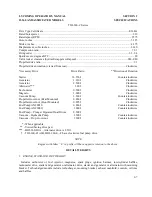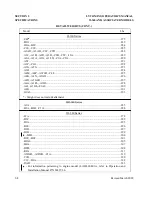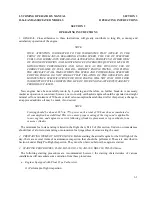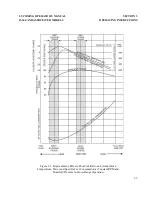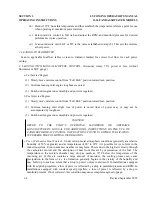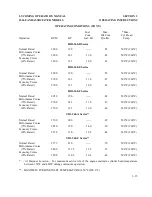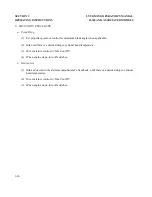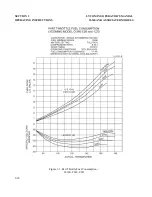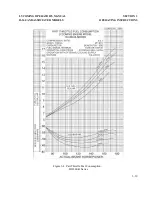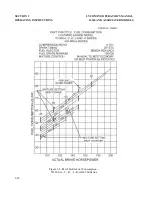
LYCOMING OPERATORS MANUAL
SECTION 3
O-360 AND ASSOCIATED MODELS
OPERATING INSTRUCTIONS
(b)
(Fixed pitch propeller).
Aircraft that are equipped with fixed pitch propellers, or not equipped
with manifold pressure gage, may check magneto drop-off with engine operating at
approximately 1800 RPM (2000 RPM maximum).
(c) Switch from both magnetos to one and note drop-off; return to both until engine regains speed
and switch to the other magneto and note drop-off, then return to both. Drop-off must not
exceed 175 RPM and must not exceed 50 RPM between magnetos. Smooth operation of the
engine but with a drop-off that exceeds the normal specification of 175 RPM is usually a sign
of propeller load condition at a rich mixture. Proceed to step e. (1) (d).
(d) If the RPM drop exceeds 175 RPM, slowly lean the mixture until the RPM peaks. Then retard
the throttle to the RPM specified in step e.(1)(a) or e.(1)(b) for the magneto check and repeat
the check. If the drop-off does not exceed 175 RPM, the difference between the magnetos does
not exceed 50 RPM, and the engine is running smoothly, then the ignition system is operating
properly. Return the mixture to full rich.
(2) Helicopter.
Raise collective pitch stick to obtain 15 inches manifold pressure at 2000 RPM.
Switch from both magnetos to one and note drop-off; return to both until engine regains speed
and switch to the other magneto and note drop-off. Drop-off must not exceed 200 RPM. Drop-off
between magnetos must not exceed 50 RPM. A smooth drop-off past normal is usually a sign of a
too lean or too rich mixture.
f. Do not operate on a single magneto for too long a period; a few seconds is usually sufficient to check
drop-off and to minimize plug fouling.
7. OPERATION IN FLIGHT.
a. See airframe manufacture
rs instructions for recommended power settings.
b. Throttle movements from full power to idle or from idle to full power are full range movements. Full
range throttle movements must be performed over a minimum time duration of 2 to 3 seconds.
Performing a full range throttle movement at a rate of less than 2 seconds is considered a rapid or
instant movement. Performing rapid movements may result in detuned counterweights which may
lead to failure of the counterweight lobes and subsequent engine damage.
c.
Fuel Mixture Leaning Procedure.
Improper fuel/air mixture during flight is responsible for engine problems, particularly during take-
off and climb power settings. The procedures described in this manual provide proper fuel/air mixture
when leaning Lycoming engines; they have proven to be both economical and practical by eliminating
excessive fuel consumption and reducing damaged parts replacement. It is therefore recommended
that operators of all Lycoming aircraft engines utilize the instructions in this publication any time the
fuel/air mixture is adjusted during flight.
Manual leaning may be monitored by exhaust gas temperature indication, fuel flow indication, and
by observation of engine speed and/or airspeed. However, whatever instruments are used in
monitoring the mixture, the following general rules must be observed by the operator of Lycoming
aircraft engines.
Revised March 2009
3-5
Содержание AIO-360 Series
Страница 13: ...This Page Intentionally Left Blank ...
Страница 15: ...This Page Intentionally Left Blank ...
Страница 21: ...This Page Intentionally Left Blank ...
Страница 23: ...This Page Intentionally Left Blank ...
Страница 35: ...This Page Intentionally Left Blank ...
Страница 37: ...This Page Intentionally Left Blank ...
Страница 105: ...This Page Intentionally Left Blank ...
Страница 107: ...This Page Intentionally Left Blank ...
Страница 121: ...This Page Intentionally Left Blank ...
Страница 123: ...This Page Intentionally Left Blank ...
Страница 131: ...This Page Intentionally Left Blank ...
Страница 149: ...This Page Intentionally Left Blank ...
Страница 151: ...SECTION 8 LYCOMING OPERATOR S MANUAL TABLES O 360 AND ASSOCIATED MODELS 8 2 ...
Страница 152: ...LYCOMING OPERATOR S MANUAL SECTION 8 O 360 AND ASSOCIATED MODELS TABLES 8 3 ...



